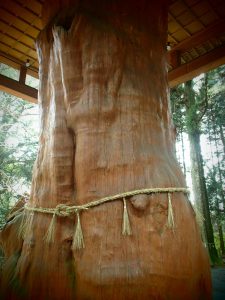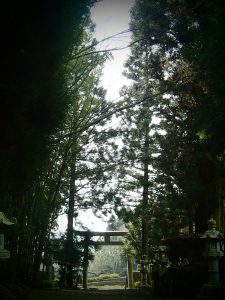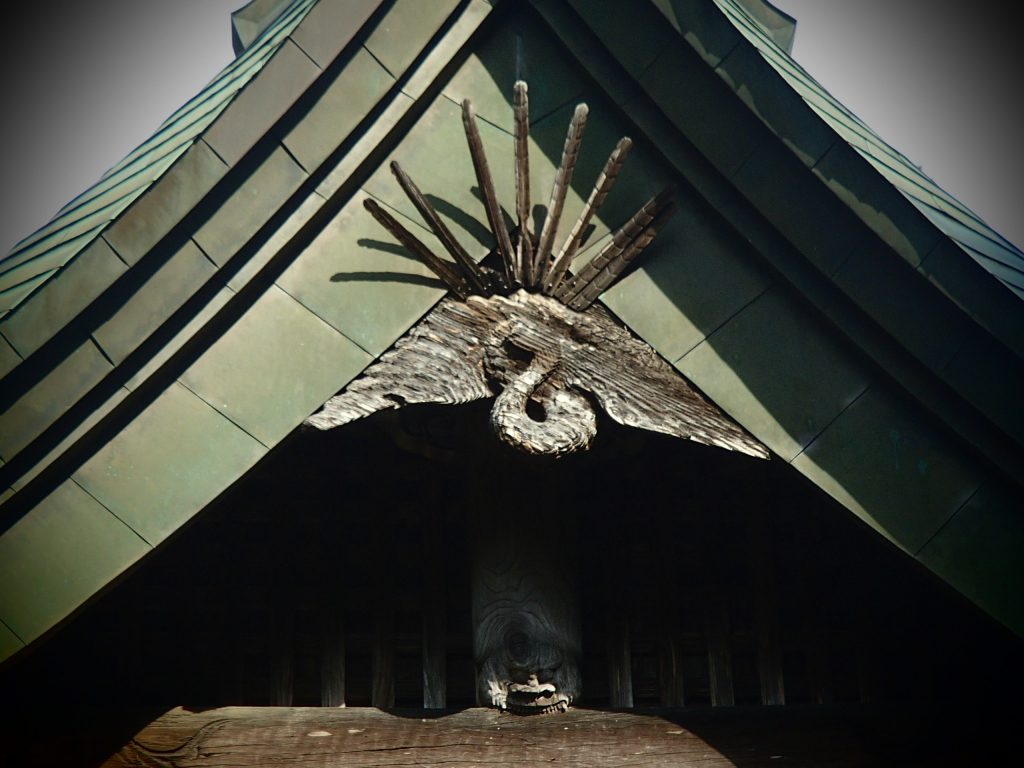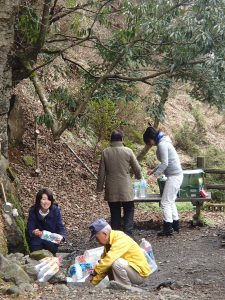Kokuzo Shrine
Tucked away in the shade of the caldera wall in the hamlet of Teno you will find the Kokuzo Shrine 国造神社. Situated only 6 km north of the better known Aso Shrine if you have time the Kokuzo shrine is definitely worth a detour.
Why visit?
 Primarily because here you can see the remains of a truly awesome tree, the great Sugi of Teno. Teno Osugi was a designated national monument rumoured to be at least 2000 years old when it fell in a typhoon in 1991. The tree was lovingly polished by the local people and stored in lavender and now the huge root section and an 11m section of the trunk stand proudly in their own pavillions protected from the elements. Measuring 11 m around the trunk and standing a towering 48 m high when alive. Climb under the root section and stand in its hollow centre and you will get a sense of how huge and majestic it must have been.
Primarily because here you can see the remains of a truly awesome tree, the great Sugi of Teno. Teno Osugi was a designated national monument rumoured to be at least 2000 years old when it fell in a typhoon in 1991. The tree was lovingly polished by the local people and stored in lavender and now the huge root section and an 11m section of the trunk stand proudly in their own pavillions protected from the elements. Measuring 11 m around the trunk and standing a towering 48 m high when alive. Climb under the root section and stand in its hollow centre and you will get a sense of how huge and majestic it must have been.
The current shrine buildings date back to the 17C, making them considerably older than the 19C Aso shrine’s. Though plain and simple, look closely and you will see some beautiful carvings and an unusual peacock decoration and an oni under the roof. The shrine surroundings are green and peaceful, lending a sacred air that you don’t find at the more urban and bustling Aso Shrine.
The Teno area is famed as being the lowest point in the northern caldera wall and it is here that spring waters gush out from under the caldera wall. If you are driving, head up the road behind the Kokuzo shrine and you will climb the caldera wall, it’s a much quicker and smoother ride than the twisting and turning Daikambo route or Route 11. On your way look out for the Teno springs gushing out of the cliff wall. There is a small parking spot and a few banners marking the spot. The water that gushes out here is said to have the highest mineral content of all of Aso’s springs. On the day I visited people from Kumamoto City and the neighbouring prefecture of Oita were busy filling up tens of bottles.
Another interesting sight near the shrine, which I did not have time to visit this time but is worth mentioning, is an ancient tomb carved into the hillside. Named the Kaminookura Tomb 上御倉 it dates back to the 6th century AD and is said to be Hayamikatama’s mausoleum. In the car park entrance you will see a small sign pointing to the left (the shrine is on your right) follow this and you should come to the tomb. The tomb is free to enter and apparently there is a small electric light that can be switched on from the outside, though the entrance is very low inside it’s large enough for several people to enter at once – happy exploring!
Kokuzo Shrine History
 The Kokuzo Shrine is said to have been founded around 100 BC making it almost as ancient as its close neighbour Aso shrine (founded 282 BC ). These shrines are some of the oldest in the country testifying to the fact that the Aso area was one of the first area’s to be settled in ancient times by the people (or gods!) who brought the rice farming culture to Japan. Agriculture and shinto religion are closely connected, in fact even to this day one of the Emperor’s duties is to grow rice. The presence of many Kofun tombs on the flat caldera plateau dating back to between the 4th and 7th Century AD also testify to the importance of the founding fathers of Aso.
The Kokuzo Shrine is said to have been founded around 100 BC making it almost as ancient as its close neighbour Aso shrine (founded 282 BC ). These shrines are some of the oldest in the country testifying to the fact that the Aso area was one of the first area’s to be settled in ancient times by the people (or gods!) who brought the rice farming culture to Japan. Agriculture and shinto religion are closely connected, in fact even to this day one of the Emperor’s duties is to grow rice. The presence of many Kofun tombs on the flat caldera plateau dating back to between the 4th and 7th Century AD also testify to the importance of the founding fathers of Aso.
All of the shrine festivals and rites in the Aso region (designated as Intangible Folk Cultural Assets) are related to rice farming. One that takes place at both Aso Shrine and Kokuzo shrine at the end of July is the Oden festival where the 12 gods of Aso shrine and 4 gods of Kokuzo shrine are taken out and paraded around the paddy fields to view the progress of the rice crop. They are accompanied by ladies covered head to toe in white carrying meals and sake for the gods on their heads. This rite is said to have originated at Kokuzo shrine and the Teno area may also have been the first place in the caldera from where rice farming spread due to the availability of natural irrigation from the Teno spring waters. The Teno locals even claim that the Kokuzo shrine pre-dates the Aso shrine and is the most ancient in the region … I wonder if we will ever know, a hint may be in the name though ‘Kokuzo ‘ 国造 translates literally as ‘国Country造 make’!
Getting there:
By car the Kokuzo shrine is just 6km from Aso Shrine, follow route 11 towards the caldera wall and turn onto route 213 by the Kojo post office then follow the signs for 国造神社. It would also be an easygoing bicycle ride as the caldera plain is flat, rental bicycles can be picked up from Aso station. Or if time is short you could put a visit to Kokuzo shrine into your customised Aso tour, contact us for details.
[codepeople-post-map]
〒869-2601 熊本県阿蘇市 一の宮町手野2110
Teno 2110, Ichinomiya, Aso Shi, Kumamoto Prefecture


